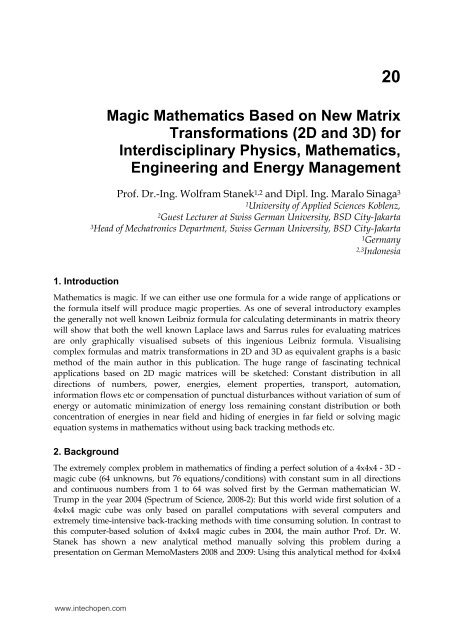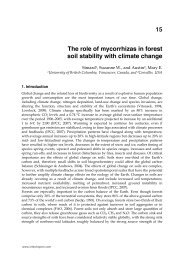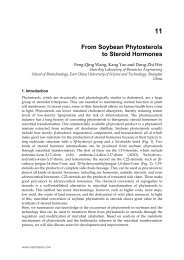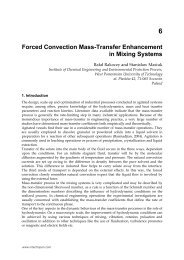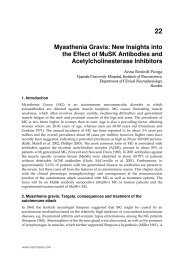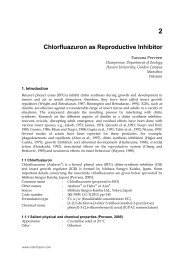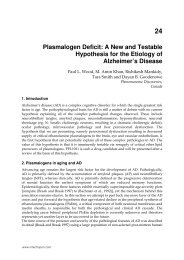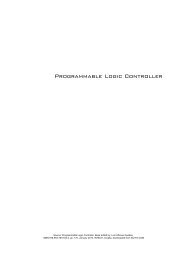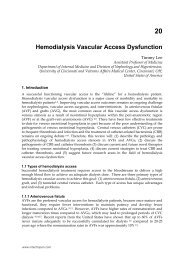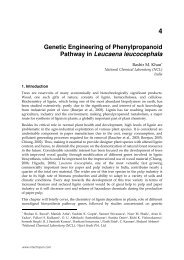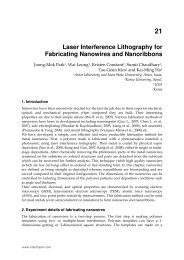Magic Mathematics Based on New Matrix Transformations ... - InTech
Magic Mathematics Based on New Matrix Transformations ... - InTech
Magic Mathematics Based on New Matrix Transformations ... - InTech
You also want an ePaper? Increase the reach of your titles
YUMPU automatically turns print PDFs into web optimized ePapers that Google loves.
1. Introducti<strong>on</strong><br />
20<br />
<str<strong>on</strong>g>Magic</str<strong>on</strong>g> <str<strong>on</strong>g>Mathematics</str<strong>on</strong>g> <str<strong>on</strong>g>Based</str<strong>on</strong>g> <strong>on</strong> <strong>New</strong> <strong>Matrix</strong><br />
Transformati<strong>on</strong>s (2D and 3D) for<br />
Interdisciplinary Physics, <str<strong>on</strong>g>Mathematics</str<strong>on</strong>g>,<br />
Engineering and Energy Management<br />
Prof. Dr.-Ing. Wolfram Stanek1,2 and Dipl. Ing. Maralo Sinaga3 1University of Applied Sciences Koblenz,<br />
2Guest Lecturer at Swiss German University, BSD City-Jakarta<br />
3Head of Mechatr<strong>on</strong>ics Department, Swiss German University, BSD City-Jakarta<br />
1Germany 2,3Ind<strong>on</strong>esia <str<strong>on</strong>g>Mathematics</str<strong>on</strong>g> is magic. If we can either use <strong>on</strong>e formula for a wide range of applicati<strong>on</strong>s or<br />
the formula itself will produce magic properties. As <strong>on</strong>e of several introductory examples<br />
the generally not well known Leibniz formula for calculating determinants in matrix theory<br />
will show that both the well known Laplace laws and Sarrus rules for evaluating matrices<br />
are <strong>on</strong>ly graphically visualised subsets of this ingenious Leibniz formula. Visualising<br />
complex formulas and matrix transformati<strong>on</strong>s in 2D and 3D as equivalent graphs is a basic<br />
method of the main author in this publicati<strong>on</strong>. The huge range of fascinating technical<br />
applicati<strong>on</strong>s based <strong>on</strong> 2D magic matrices will be sketched: C<strong>on</strong>stant distributi<strong>on</strong> in all<br />
directi<strong>on</strong>s of numbers, power, energies, element properties, transport, automati<strong>on</strong>,<br />
informati<strong>on</strong> flows etc or compensati<strong>on</strong> of punctual disturbances without variati<strong>on</strong> of sum of<br />
energy or automatic minimizati<strong>on</strong> of energy loss remaining c<strong>on</strong>stant distributi<strong>on</strong> or both<br />
c<strong>on</strong>centrati<strong>on</strong> of energies in near field and hiding of energies in far field or solving magic<br />
equati<strong>on</strong> systems in mathematics without using back tracking methods etc.<br />
2. Background<br />
The extremely complex problem in mathematics of finding a perfect soluti<strong>on</strong> of a 4x4x4 - 3D -<br />
magic cube (64 unknowns, but 76 equati<strong>on</strong>s/c<strong>on</strong>diti<strong>on</strong>s) with c<strong>on</strong>stant sum in all directi<strong>on</strong>s<br />
and c<strong>on</strong>tinuous numbers from 1 to 64 was solved first by the German mathematician W.<br />
Trump in the year 2004 (Spectrum of Science, 2008-2): But this world wide first soluti<strong>on</strong> of a<br />
4x4x4 magic cube was <strong>on</strong>ly based <strong>on</strong> parallel computati<strong>on</strong>s with several computers and<br />
extremely time-intensive back-tracking methods with time c<strong>on</strong>suming soluti<strong>on</strong>. In c<strong>on</strong>trast to<br />
this computer-based soluti<strong>on</strong> of 4x4x4 magic cubes in 2004, the main author Prof. Dr. W.<br />
Stanek has shown a new analytical method manually solving this problem during a<br />
presentati<strong>on</strong> <strong>on</strong> German MemoMasters 2008 and 2009: Using this analytical method for 4x4x4<br />
www.intechopen.com
<str<strong>on</strong>g>Magic</str<strong>on</strong>g> <str<strong>on</strong>g>Mathematics</str<strong>on</strong>g> <str<strong>on</strong>g>Based</str<strong>on</strong>g> <strong>on</strong> <strong>New</strong> <strong>Matrix</strong> Transformati<strong>on</strong>s (2D and 3D)<br />
for Interdisciplinary Physics, <str<strong>on</strong>g>Mathematics</str<strong>on</strong>g>, Engineering and Energy Management<br />
Step 1. Start with any magic 4x4 matrix M1,<br />
Step 2. M1 is reflected in all sides of the box.<br />
Step 3. Use the logic method, match all the edge cells<br />
Step 4. From M1 until M4, magic cube 2 is c<strong>on</strong>structed using surface transformati<strong>on</strong>,<br />
bending, or reflecting (mirroring).<br />
The computer based magic cube soluti<strong>on</strong>, which is discovered in 2004 with highest degree of<br />
perfecti<strong>on</strong> is first in 2008 analytically solved by the main author. The soluti<strong>on</strong> ideas and the<br />
important steps using the Stanek Method to solve the magic cube will be shown in the<br />
following pages and a pattern soluti<strong>on</strong> is attached.<br />
6. Short informati<strong>on</strong>: magic cube with Stanek-Method analysis<br />
In the above shown graphical method the soluti<strong>on</strong> of magic cube is explained.<br />
All related data of „Sudoku to the power of 3“applicati<strong>on</strong> will be simple and always enough<br />
to solve or to c<strong>on</strong>struct in the 4 main layers.<br />
6.1 Example: magic + ultra-magic square and cube<br />
A magic square is bi-magic (or multi-magic) if it remains magic after each of its number has<br />
been squared and an ultra magic square has more extended properties. The following 4x4<br />
square shows an example of ultra magic square (Fig. 5.(a)).<br />
(a) (b) (c)<br />
Fig. 5. (a) Perfect square or ultra-magic square with c<strong>on</strong>tinuous number 1 to 16 all rows,<br />
columns, diag<strong>on</strong>als, and four neighbor cells always resulting magic sums = 34<br />
(b) <str<strong>on</strong>g>Magic</str<strong>on</strong>g> Cube developed from magic square, with c<strong>on</strong>tinuous number 1 to 16 in 3D,<br />
resulting a perfect magic sum=34 in rows, columns, diag<strong>on</strong>als<br />
(c) <str<strong>on</strong>g>Magic</str<strong>on</strong>g> Cube developed from magic square, with number 1 to 64 in 3D, resulting<br />
a perfect magic sum=130 in rows, columns, diag<strong>on</strong>als in x-,y-, and z-planes (Stanek, 2009)<br />
www.intechopen.com<br />
383
384<br />
Products and Services; from R&D to Final Soluti<strong>on</strong>s<br />
The sum of all numbers in the horiz<strong>on</strong>tal, the vertical as well as in the diag<strong>on</strong>als are equal<br />
and also the sum of all four neighbor cells, which form a square are always c<strong>on</strong>stant to 34.<br />
The square pattern in Duerer’s square and Loh Shu’s square are easy to memorised. Starting<br />
with predetermined Loh Shu’s pattern, a 9x9 squares can be c<strong>on</strong>structed easily by applying<br />
a shifting, reflecting method.<br />
A magic cube with 4x4x4 dimensi<strong>on</strong> can be developed for instance from the known Duerer’s<br />
square pattern, or extended from ultra magic square, c<strong>on</strong>verted by reflecting, shifting and<br />
bending.<br />
6.2 An ultramagic square as the base of Stanek Cube Developments<br />
Each of 48 given ultra-magic matrices or squares results in a new magic cube with a<br />
maximum possible degree of perfecti<strong>on</strong>. Through simple transformati<strong>on</strong>, (shifting, rotating<br />
and reflecting) it is easy to c<strong>on</strong>struct other ultra magic matrices.<br />
Fig. 5. 48 possible magic squares, c<strong>on</strong>structed through shifting, rotating and reflecting.<br />
7. Soluti<strong>on</strong> by using mnem<strong>on</strong>ic scheme for Stanek Cube No.1 + No.2<br />
On the Fig. 4 it is shown how to generate and to develop a magic square and magic cubes<br />
from a given ultra-magic square. An example is the square number 22 shown in the Fig. 5.<br />
www.intechopen.com
<str<strong>on</strong>g>Magic</str<strong>on</strong>g> <str<strong>on</strong>g>Mathematics</str<strong>on</strong>g> <str<strong>on</strong>g>Based</str<strong>on</strong>g> <strong>on</strong> <strong>New</strong> <strong>Matrix</strong> Transformati<strong>on</strong>s (2D and 3D)<br />
for Interdisciplinary Physics, <str<strong>on</strong>g>Mathematics</str<strong>on</strong>g>, Engineering and Energy Management<br />
(given by the audience at MemoMasters – MindFestival 2009 to Prof. W. Stanek for manual<br />
soluti<strong>on</strong>). Starting by choosing this ultra magic square number 22 as the start matrix M1, the<br />
next ultra magic square M2 is created by using the reflecting (mirroring) method. Then from<br />
matrix M2 we can c<strong>on</strong>struct the next matrix M3 by transposing and at the same time<br />
reflecting the c<strong>on</strong>tent of cells and finally the matrix M4 is generated from M3 using<br />
reflecting in each four neighbor cells (number 1 to 16).<br />
The resulting ultra-magic matrices M1 until M4 are used to develop the next layers; creating<br />
the magic cube layers with a sketching pattern (+0, +16, +32, +48), as shown in the Fig.6.<br />
Fig. 6. Pattern Soluti<strong>on</strong> to solve a magic cube (Stanek, 2009)<br />
www.intechopen.com<br />
385
386<br />
Products and Services; from R&D to Final Soluti<strong>on</strong>s<br />
7.1 First comparis<strong>on</strong>: computer and analytical soluti<strong>on</strong> with highest degree of<br />
perfecti<strong>on</strong><br />
A comparis<strong>on</strong> between a soluti<strong>on</strong> which was reached by using computer backtracking<br />
method (W. Trump, 2004) and an analytical soluti<strong>on</strong> using logic and brain memory shows<br />
that the Stanek analytical soluti<strong>on</strong> delivers the highest perfect precisi<strong>on</strong> of magic cube<br />
(MemoMasters 2008).<br />
Fig. 7. (a) <str<strong>on</strong>g>Magic</str<strong>on</strong>g> cube, computer soluti<strong>on</strong> by W.Trump (Spektrum Wissenschaft, 2008)<br />
(b) Analytical soluti<strong>on</strong> by Prof. Wolfram Stanek.<br />
This result for the specific analytical cube was predictable, since a start ultra-magic matrix<br />
was chosen. The result in Fig. 7.(a) was shown in “Spektrum der Wissenschaft”, 2008 and<br />
the Fig. 7.(b) was represented <strong>on</strong> MindFestival in August 2009. In all the transformati<strong>on</strong>s of<br />
planes in the space partially some magical sum properties are lost. If many magical<br />
properties in the initial matrix are available (at ultra magic matrix of the case), the result of<br />
the magic cube (1-64) has a relatively highest degree of perfecti<strong>on</strong>.<br />
7.2 Sec<strong>on</strong>d comparis<strong>on</strong>: minimising the deviati<strong>on</strong> of space diag<strong>on</strong>als with computer<br />
and analytical methods<br />
By choosing the Duerer’s matrix, which is not perfect, a magic matrix is created as the start<br />
matrix in developing other magic cubes as shown in the Fig. 8.<br />
The Fig.9 shows the difference between W.Trump’s magic cube which is solved by<br />
computer and the main author’s analytical soluti<strong>on</strong> by starting with the magic matrix in the<br />
www.intechopen.com
<str<strong>on</strong>g>Magic</str<strong>on</strong>g> <str<strong>on</strong>g>Mathematics</str<strong>on</strong>g> <str<strong>on</strong>g>Based</str<strong>on</strong>g> <strong>on</strong> <strong>New</strong> <strong>Matrix</strong> Transformati<strong>on</strong>s (2D and 3D)<br />
for Interdisciplinary Physics, <str<strong>on</strong>g>Mathematics</str<strong>on</strong>g>, Engineering and Energy Management<br />
previous Fig. 8. The gray areas in the figure represent the difference between both soluti<strong>on</strong>s.<br />
In the right column is shown the magic cube, which is c<strong>on</strong>structed through twisted matrix<br />
transformati<strong>on</strong>. The highlighted cells (rows, column and diag<strong>on</strong>als) produce the c<strong>on</strong>stant<br />
sum of the magic cube.<br />
Fig. 8. C<strong>on</strong>structing a magic cube, starting with Duerer’s matrix (Stanek, 2009)<br />
Computer Soluti<strong>on</strong> Analytical Soluti<strong>on</strong>s with Stanek-Method<br />
by W.Trump:<br />
Fig. 9. Complete soluti<strong>on</strong> to build magic matrices and magic cube with highest symmetry<br />
(Stanek, 2009)<br />
The comparis<strong>on</strong> also shows that the Stanek analytical method works magically not <strong>on</strong>ly in<br />
start-matrix of ultra-magic, but also in normal magical start squares, which have at least<br />
partly-some pandiag<strong>on</strong>al magic properties. In Duerer's matrix the major side-diag<strong>on</strong>als (e.g.<br />
2 +10 +9 +1 = 22, etc) are not magical, but parts of the side-diag<strong>on</strong>al always have a magic<br />
c<strong>on</strong>stant (e.g. 3 +5 +14 +12 = 34, etc).<br />
www.intechopen.com<br />
387
<str<strong>on</strong>g>Magic</str<strong>on</strong>g> <str<strong>on</strong>g>Mathematics</str<strong>on</strong>g> <str<strong>on</strong>g>Based</str<strong>on</strong>g> <strong>on</strong> <strong>New</strong> <strong>Matrix</strong> Transformati<strong>on</strong>s (2D and 3D)<br />
for Interdisciplinary Physics, <str<strong>on</strong>g>Mathematics</str<strong>on</strong>g>, Engineering and Energy Management<br />
8.1 Strategy-checks ”Sudoku to the Power of X” + scientific and technological point<br />
of view.<br />
(A) “Sudoku to the power of 3“with ultra-magic Start-squares & Stanek-Method.<br />
1. C<strong>on</strong>structing 11 new magic squares from 1 ultra magic square; select any ultra magic<br />
square from Fig. 5 <strong>on</strong> page 7 (manually, required time: less than 90 sec<strong>on</strong>ds)<br />
2. C<strong>on</strong>structing near perfect magic cube no. 1 (number 1 to 16) from point A.1.<br />
3. C<strong>on</strong>structing any possible perfect magic cube no.2 (number 1 to 64) from point A.2<br />
Notes:<br />
Until 2004 this mathematical problem was thought to be unsolvable, then in 2004 it was<br />
solved by Trump using parallel computing of computers and backtracking method; in<br />
2008 this problem was solved analytically and finally in 2009 it is solved by using the<br />
Stanek-Pattern Strategy during MemoMasters 2009.<br />
For Strategy B and Strategy C improvement, try your own “creative intelligence “ in logic<br />
and mathematic areas.<br />
Try to select a soluti<strong>on</strong> strategy from the following improvement that you can find quickly.<br />
(B) “Sudoku to the power of 3“: Additi<strong>on</strong>al Strategy to 4x4x4-Stanek-Cube and 3x3x3-<br />
Rubik-cube<br />
1. Try to find an extensi<strong>on</strong> strategy for a Stanek magic cube with a given sum value<br />
greater than 130; example the magic sum equals 274 and the maximal number in the<br />
cube equals 100.<br />
2. C<strong>on</strong>struct with this extensi<strong>on</strong> (just additi<strong>on</strong>) the new cube directly from point A.3<br />
3. Try to apply the Stanek-strategy to generate an arbitrary sum-number (see page 5) for<br />
the color rubik cube (divisible by 3).<br />
(C) “Sudoku to the power of 2“ = Combinati<strong>on</strong> of Sudoku and interesting special magic<br />
squares<br />
1. C<strong>on</strong>structing a magic 4x4-Sudoku X with four 2x2-fields (with each number 1- 4)<br />
2. Apply the 3x3-Loh-Shu-square, included design rule, so that each odd-square nxn<br />
(n = 3, 5, 7, 9, ... etc) can be c<strong>on</strong>structed immediately.<br />
Note: Positi<strong>on</strong> of Serial numbers 1-9 including the soluti<strong>on</strong> scheme. Start-number 1 is<br />
always above in the middle, No. 2 in the right column below.<br />
3. C<strong>on</strong>struct a 9x9 magic square Y with this method from C.2: All rows, columns and main<br />
diag<strong>on</strong>als have a c<strong>on</strong>stant sum<br />
Example, n=9, then S=396, etc.<br />
For magic cube magic sum<br />
S= n x (n x n +1) / 2 for number from 1 to n 2.<br />
389<br />
S = n x (n x n x n +1) / 2, for number from 1 to n 3 (5)<br />
example 4x4x4- cube, n=4 then S = 130, etc<br />
4. Try to prepare a 4x4 magic square (magic or ultra-magic square) so that for any<br />
number, the sum of all numbers in all rows, columns and main diag<strong>on</strong>als are equal.<br />
5.a). C<strong>on</strong>struct a 9x9-magic Sudoku A from a 3x3-Loh-Shu-square.<br />
5.b).C<strong>on</strong>struct a 9x9-magic Sudoku B from Sudoku A in 5.a).<br />
www.intechopen.com
392<br />
Products and Services; from R&D to Final Soluti<strong>on</strong>s<br />
Fig. 11. MATLAB® program listing for test algorithm, with A, B, C, D equal to +0, +16, +32, +48.<br />
(Stanek, 2010)<br />
www.intechopen.com
<str<strong>on</strong>g>Magic</str<strong>on</strong>g> <str<strong>on</strong>g>Mathematics</str<strong>on</strong>g> <str<strong>on</strong>g>Based</str<strong>on</strong>g> <strong>on</strong> <strong>New</strong> <strong>Matrix</strong> Transformati<strong>on</strong>s (2D and 3D)<br />
for Interdisciplinary Physics, <str<strong>on</strong>g>Mathematics</str<strong>on</strong>g>, Engineering and Energy Management<br />
Fig. 12. Distributi<strong>on</strong> of c<strong>on</strong>tinuous number 1 to 64 in the magic cube (Stanek, 2010)<br />
Fig. 13. <str<strong>on</strong>g>Magic</str<strong>on</strong>g> sum of rows, column, and diag<strong>on</strong>als (Stanek, 2010)<br />
www.intechopen.com<br />
393
394<br />
INPUTS<br />
1<br />
2<br />
3<br />
4<br />
M<br />
M<br />
M<br />
M<br />
Electric<br />
Motors<br />
C<strong>on</strong>veyors<br />
C<strong>on</strong>veyors<br />
C<strong>on</strong>veyors<br />
C<strong>on</strong>veyors<br />
16<br />
5<br />
9<br />
4<br />
3<br />
M<br />
M<br />
M<br />
M<br />
Electric<br />
Motors<br />
2<br />
10 11<br />
6 7<br />
15<br />
14<br />
C<strong>on</strong>veyors<br />
C<strong>on</strong>veyors<br />
C<strong>on</strong>veyors<br />
C<strong>on</strong>veyors<br />
Products and Services; from R&D to Final Soluti<strong>on</strong>s<br />
M<br />
M<br />
M<br />
M<br />
Electric<br />
Motors<br />
(a) Technology<br />
13<br />
8<br />
12<br />
1<br />
C<strong>on</strong>veyors<br />
C<strong>on</strong>veyors<br />
C<strong>on</strong>veyors<br />
C<strong>on</strong>veyors<br />
104<br />
8<br />
5<br />
83<br />
6<br />
M<br />
M<br />
M<br />
M<br />
Electric<br />
Motors<br />
81<br />
82 7<br />
101 10<br />
102<br />
C<strong>on</strong>veyors<br />
C<strong>on</strong>veyors<br />
C<strong>on</strong>veyors<br />
C<strong>on</strong>veyors<br />
103<br />
(b) C<strong>on</strong>tinuous power (c) Clustered power<br />
Fig. 14. (a) Example of magic square applicati<strong>on</strong> in the producti<strong>on</strong> line, with the maximum<br />
power distributi<strong>on</strong> per row and column less than 200kW (Stanek, 2010)<br />
(b) Start <strong>Matrix</strong>, i.e. Duerer matrix, (c) C<strong>on</strong>structed magic matrix, shows the distributed<br />
power in each row using i.e. 4 main power drives and smaller sub-drives, column and<br />
diag<strong>on</strong>al are c<strong>on</strong>stant sum of 200kW.<br />
To produce a c<strong>on</strong>stant amount of producti<strong>on</strong> in any row, how is the energy and motor<br />
power respectively distributed without exceeding maximum power of i.e. 200 kW, total<br />
maximum power c<strong>on</strong>sumpti<strong>on</strong> per c<strong>on</strong>veyor-line is derived from Duerer start-matrix in Fig.<br />
14 (b) and developed into power distributi<strong>on</strong> as shown in the Fig. 14 (c).<br />
An example of a 4x4 magic square with c<strong>on</strong>stant sum zero, known as zero-sum matrix, is<br />
shows in the Fig. 16.<br />
The represented matrix is derived from a magic matrix by additi<strong>on</strong> and subtracting of cell<br />
c<strong>on</strong>tents with a c<strong>on</strong>stant, so the resulting matrix has a magic c<strong>on</strong>stant sum zero. This can be<br />
applied to the design of coils or transformer windings as shown in the next Fig. 15.Another<br />
example is if we apply the magic square 2D to c<strong>on</strong>struct real 3D applicati<strong>on</strong>s in magnetic<br />
field as shown in the Fig 15 and Fig. 16. It shows the symmetry with focus <strong>on</strong> separate x-, y-,<br />
and z-regi<strong>on</strong>s.<br />
Real applicati<strong>on</strong>s with totally different features in all cells of 3D can be optimised with<br />
c<strong>on</strong>stant sums in arbitrary directi<strong>on</strong>s using the real magic-matrix algorithm for 4x4x4 cubes<br />
shown in Fig. 6 to Fig. 10.<br />
From the Fig. 15 (a) can be seen that the spatial field is zero due to the symmetry of the<br />
magic matrix in developing of the windings currents. The sum of all four-cell-clusters is<br />
always zero. This phenomen<strong>on</strong> might be theoretically interpreted as a galaxy black hole, too.<br />
The magic square and cube could be applied also in other science and technology fields,<br />
such as energy management, flow management, logistics, and thermodynamics etc. See the<br />
spectrum of possible magic –matrix applicati<strong>on</strong>s in secti<strong>on</strong> 7.1 too.<br />
www.intechopen.com<br />
11<br />
9<br />
84<br />
4<br />
1<br />
2<br />
3<br />
4<br />
OUTPUTS
<str<strong>on</strong>g>Magic</str<strong>on</strong>g> <str<strong>on</strong>g>Mathematics</str<strong>on</strong>g> <str<strong>on</strong>g>Based</str<strong>on</strong>g> <strong>on</strong> <strong>New</strong> <strong>Matrix</strong> Transformati<strong>on</strong>s (2D and 3D)<br />
for Interdisciplinary Physics, <str<strong>on</strong>g>Mathematics</str<strong>on</strong>g>, Engineering and Energy Management<br />
Fig. 15. Current windings design with semi-magic & ultra-magic matrices<br />
www.intechopen.com<br />
395
396<br />
Fig. 16. Current windings and field design with magic ZERO matrices<br />
9. Acknowledgements<br />
Products and Services; from R&D to Final Soluti<strong>on</strong>s<br />
Thanks of main author to his appreciated colleague and co-author Dipl. Ing. Maralo Sinaga<br />
from SGU-Asia for adaptati<strong>on</strong> and compressi<strong>on</strong> of central magic matrix developments<br />
based <strong>on</strong> W.Stanek’s research and publicati<strong>on</strong> (refer list of publicati<strong>on</strong>s).<br />
Thanks of main author also to the SGU internship student Martin Eka Putra, Jemmi Dianto<br />
and assistant Florian Halfmann from University of Applied Sciences, Koblenz, testing the<br />
new 3D algorithm for arbitrary 64 cells magic cube with MATLAB®.<br />
10. References<br />
www.wolfram-stanek.de/stanek_sudoku_hoch_3_magisch_mindfestival2009.pdf<br />
www.memomasters.de , “Mensch schlägt Computer”; MemoMasters 2009, 2008, Germany.<br />
Spektrum der Wissenschaft, 2008-2,<br />
Stanek Wolfram Prof, www.wolfram-stanek.de, 2010<br />
http://en.wikipedia.org/wiki/<str<strong>on</strong>g>Magic</str<strong>on</strong>g>_square<br />
http://www.multimagie.com/bi-magic squares<br />
www.intechopen.com


